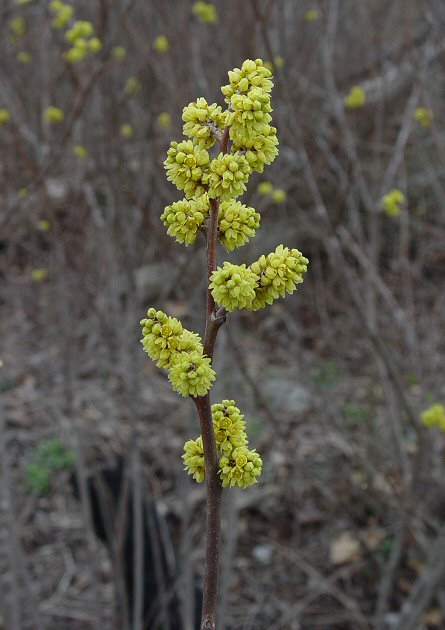Rhus aromatica Aiton
Fragrant Sumac

Native
CC = Amb
CW = 5
MOC = 90
© DETenaglia
Rhus aromatica AitonFragrant Sumac | |
 |
Native CC = Amb CW = 5 MOC = 90 |
© DETenaglia |
|
Family - Anacardiaceae Habit - Shrub, usually dioecious. Stems - Ascending to erect, to 1.5 m, multiple from base, . Branches nearly glabrous to densely hairy, aromatic when bruised. Leaves - Alternate, trifoliate, petiolate, deciduous. Petioles 1.0-2.5 cm long. Leaflets variable in shape and lobing, nearly glabrous to densely pubescent, the terminal leaflet sessile, broadly ovate to rhombic, 4-9 cm long, 2-8 cm wide, scalloped or toothed near the tip, entire and angled at the base.
Inflorescences - Terminal, small panicles with spicate branches, 2-6 cm long, 1-3 cm wide, the branches occasionally relatively small and appearing as dense clusters of flowers. Flower stalks 1-3 mm long.
Flowers - Sepals 5, united at base, lanceolate, 1.0-1.4 mm long, 0.3-0.4 mm wide, broadly rounded at the tip, the surfaces glabrous, reddish brown, the margins with nonglandular hairs. Petals 5, free, oblong-obovate, 1.6-2.5 mm long, rounded at the tip, glabrous or hairy on the inner surface, yellow. Stamens 5, erect, yellowish. Anthers, 0.5 mm in diameter, yellow-orange. Style 1, 3-lobed. Ovary surrounded by yellow disk.
Fruits - Drupes 5-7 mm long, 4-6 mm wide, red, slightly flattened, pubescent with dense, minute, stout, red glandular hairs and sparse to dense, white to colorless nonglandular hairs.
Flowering - March - May. Habitat - Rocky open woods, glades, bluffs, savannas, fields, roadsides, railroads. Origin - Native to the U.S. Other info. - This is a common and highly variable species which occurs, at least in some form, throughout Missouri and most of the continental U.S. The leaves alone are generally sufficient for identification of the most common form of the plant. The central leaflet is not stalked (which serves to differentiate this plant from poison ivy, which has a stalked terminal leaflet), but instead is distinctively long-tapered back to the node. The early spring inflorescences, and the hairy fruits which appear later, are also very distinctive. Pubescence of leaves and twigs is variable. Photographs taken at Danville Conservation Area, Montgomery County, MO., 3-30-04, and at Guntersville State Park, AL., 5-22-04 (DETenaglia); also in Weldon Spring Conservation Area, St. Charles County, MO, 5-18-2008, Shaw Nature Reserve, Franklin County, MO, 5-27-2015, 5-17-2023, and 3-17-2025, and along the Katy Trail near Dutzow, Warren County, MO, 4-17-2018 (SRTurner). |